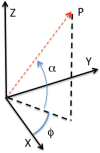Imaging of underground cavities with cosmic-ray muons from observations at Mt. Echia (Naples)
- PMID: 28446789
- PMCID: PMC5430851
- DOI: 10.1038/s41598-017-01277-3
Imaging of underground cavities with cosmic-ray muons from observations at Mt. Echia (Naples)
Abstract
Muography is an imaging technique based on the measurement of absorption profiles for muons as they pass through rocks and earth. Muons are produced in the interactions of high-energy cosmic rays in the Earth's atmosphere. The technique is conceptually similar to usual X-ray radiography, but with extended capabilities of investigating over much larger thicknesses of matter thanks to the penetrating power of high-energy muons. Over the centuries a complex system of cavities has been excavated in the yellow tuff of Mt. Echia, the site of the earliest settlement of the city of Naples in the 8th century BC. A new generation muon detector designed by us, was installed under a total rock overburden of about 40 metres. A 26 days pilot run provided about 14 millions of muon events. A comparison of the measured and expected muon fluxes improved the knowledge of the average rock density. The observation of known cavities proved the validity of the muographic technique. Hints on the existence of a so far unknown cavity was obtained. The success of the investigation reported here demonstrates the substantial progress of muography in underground imaging and is likely to open new avenues for its widespread utilisation.
Conflict of interest statement
The authors declare that they have no competing interests.
Figures




















Similar articles
-
3D Muography for the Search of Hidden Cavities.Sci Rep. 2019 Feb 27;9(1):2974. doi: 10.1038/s41598-019-39682-5. Sci Rep. 2019. PMID: 30814618 Free PMC article.
-
Applications of muon absorption radiography to the fields of archaeology and civil engineering.Philos Trans A Math Phys Eng Sci. 2018 Dec 10;377(2137):20180057. doi: 10.1098/rsta.2018.0057. Philos Trans A Math Phys Eng Sci. 2018. PMID: 30530534 Free PMC article.
-
Principles and Perspectives of Radiographic Imaging with Muons.J Imaging. 2021 Nov 26;7(12):253. doi: 10.3390/jimaging7120253. J Imaging. 2021. PMID: 34940720 Free PMC article. Review.
-
Muography applications developed by IFIN-HH.Philos Trans A Math Phys Eng Sci. 2018 Dec 10;377(2137):20180137. doi: 10.1098/rsta.2018.0137. Philos Trans A Math Phys Eng Sci. 2018. PMID: 30530545 Free PMC article.
-
Muon geotomography: selected case studies.Philos Trans A Math Phys Eng Sci. 2018 Dec 10;377(2137):20180061. doi: 10.1098/rsta.2018.0061. Philos Trans A Math Phys Eng Sci. 2018. PMID: 30530537 Review.
Cited by
-
A portable muon telescope based on small and gas-tight resistive plate chambers.Philos Trans A Math Phys Eng Sci. 2018 Dec 10;377(2137):20180139. doi: 10.1098/rsta.2018.0139. Philos Trans A Math Phys Eng Sci. 2018. PMID: 30530546 Free PMC article.
-
Hidden chamber discovery in the underground Hellenistic necropolis of Neapolis by muography.Sci Rep. 2023 Apr 3;13(1):5438. doi: 10.1038/s41598-023-32626-0. Sci Rep. 2023. PMID: 37012348 Free PMC article.
-
Muometric positioning system (μPS) with cosmic muons as a new underwater and underground positioning technique.Sci Rep. 2020 Nov 3;10(1):18896. doi: 10.1038/s41598-020-75843-7. Sci Rep. 2020. PMID: 33144620 Free PMC article.
-
Investigation of the limits of high-definition muography for observation of Mt Sakurajima.Philos Trans A Math Phys Eng Sci. 2018 Dec 10;377(2137):20180135. doi: 10.1098/rsta.2018.0135. Philos Trans A Math Phys Eng Sci. 2018. PMID: 30530543 Free PMC article.
-
Periodic sea-level oscillation in Tokyo Bay detected with the Tokyo-Bay seafloor hyper-kilometric submarine deep detector (TS-HKMSDD).Sci Rep. 2022 Apr 12;12(1):6097. doi: 10.1038/s41598-022-10078-2. Sci Rep. 2022. PMID: 35414679 Free PMC article.
References
-
- George, E. P. Cosmic rays measure of overburden of tunnel. Commonwealth Eng. 455–7 (1955).
-
- Okubo S, Tanaka HKM. Imaging the density profile of a volcano interior with cosmic-ray muon radiography combined with classical gravimetry. Meas. Sci. and Technol. 2012;23:042001. doi: 10.1088/0957-0233/23/4/042001. - DOI
-
- Saracino, G. & Carlôganu, C. Looking at volcanoes with cosmic-ray muons. Physics Today65, number 12, 60–61 (2012).
Publication types
LinkOut - more resources
Full Text Sources
Other Literature Sources

